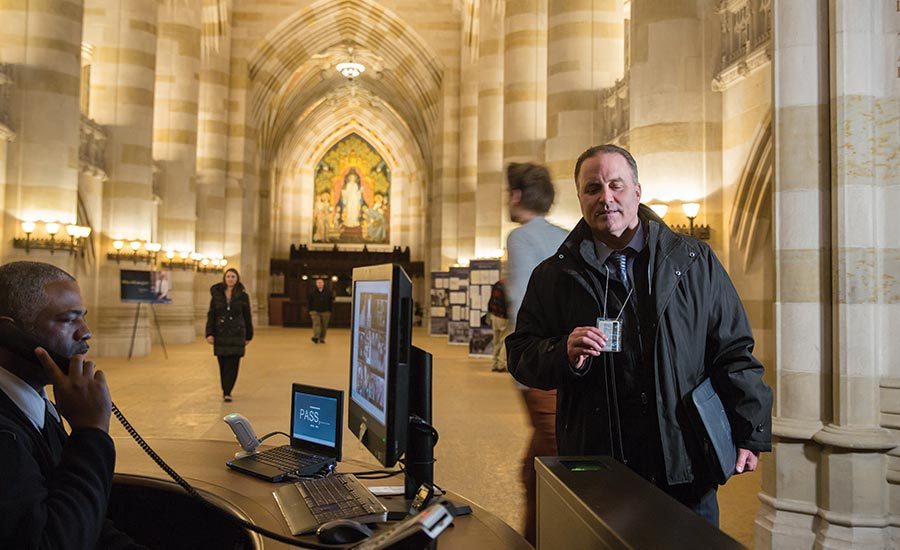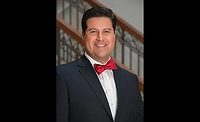Bike thefts, drug abuse, assaults and other violent crimes, protest-counterprotest melees, and cyber hackers are crowding onto the ever-expanding plates of college and university police and security forces. But those in the field say they’re up to those myriad challenges thanks to the combination of equipment, technology and training they can bring to bear.
Rick Tupper, director of campus safety at Augustana University in Sioux Falls, S.D., who spent 20 years in public law enforcement, enjoys the dynamic environment of a campus and the challenges of being a community inside a larger community.
“Probably half of what my officers end up dealing with isn’t directly related to the institution,” he says. “Universities and campuses are magnets. People want to be part of it. They aren’t all coming for good reasons – sex offenders, window-peeking, thefts, we see a lot of the outside world coming into the campus because it’s a target-rich environment. We’re trying to create an open, welcoming environment that all administrators want campus to be, while at the same time, combating those who want to take advantage.”
The controversy at the University of Virginia over the white nationalist demonstrations in August is only the latest manifestation of how campuses can becoming boiling points for searing societal issues, Tupper says. “If you want to have a free speech area, or you want to engage people, campuses are that magnet,” he says. “You always have somebody who wants to capitalize on your location to get their message out. How do we engage them in a civil way?”
That requires a balance somewhere between law enforcement not “looking like an army” while having the resources in place to “keep the flow of the institution,” all on limited budgets, Tupper says. “Nobody wants to pay for it, but when you need it, you want to have the best coverage,” he says. During a crisis, “It’s too late to increase your coverage. I can’t go back and say, ‘I want full coverage.’ It’s trying to get people to plan for it. We do come with a cost.”
Part of that cost is adequately preparing officers for a crowd management scenario in which not having access to a gas mask, for example, might be a liability, Tupper says. “What type of gear do you need to have on hand?” he says. “We’re making sure that we have the right tools to deal with those types of situations.”
Campus safety personnel at Augustana work to engage the campus community to be their eyes and ears, Tupper says. “You need to engage them to be part of the solution,” he says. “There are so many different groups – students that come from all over the country and the world, faculty and visitors to campus. They each come with a little different expectation, and they bring their own issues with them.” Plus, there’s a new group of freshmen each year. “As soon as we educate one group, they move on and we get a whole new group.”
As such, training of both his department and the wider community is probably the most important topic, ranging from mental health issues to crowd management. “In each of those scenarios, we’re engaging partners like the local police department and other agencies who would be participating,” Tupper says. “We make sure we address that old adage that the time of crisis is not the first time you should be meeting somebody. We overlap all of our training with different parts of campus, like athletics, in terms of how they can be a player.”
On the technology front, college campuses are considering issues like whether body cameras for officers make sense, Tupper says. “It’s pretty simple to say you’re going to start buying body cameras,” he says. “There’s so many things people don’t think about – storage capacity, how long you retain data, who’s going to be able to view them. Data storage comes with a cost.” Plus, he adds, they amount to “a mini-sized TV plated in the middle of your chest. They’re not the easiest thing to be lugging around.”
Tupper has seen more momentum in the area of freestanding cameras in public places. But in a city of 180,000 people, cameras also take in city streets, which raises issues like whether footage can or should be made available to an insurance company in the event that it captures a motor vehicle accident. And campuses are looking at replacing analog cameras with Internet-connected ones, and pan-tilt-zoom with a 360-degree view. “Of course, it all comes with a cost,” he notes.
Teaming with IT at Yale
Yale University, located in New Haven, Conn., has been sorting out security priorities and formulating remedies through a partnership among the police, security and information technology departments that dates to the late 2000s.
The IT director at that time began “embedding” two staff with both the police and security departments so they could better understand what law enforcement faced and be in a position to suggest more innovative technological solutions based on their granular knowledge of how end users will be using the systems.
“We run all the systems and the information technology hardware for public safety,” says David Boyd, director of information technology for public safety. “We work with them on a daily basis to understand their business, understand their pain points and look for technology solutions that increase efficiency and effectiveness, and reduce costs, while maintaining their level of service.”
Yale’s crime-fighting efforts are based on 93 police officers, 150 security officers and 1,600 cameras, but those resources need to be properly coordinated and leveraged, says Ronnell Higgins, director of public safety and chief of police. “Having Dave’s team embedded with us enables them to not just hear but also to understand the culture of campus safety and how it’s provided here at Yale,” he says. “They understand the nuances that may exist in systems, and they identify gaps and emerging trends to help us improve efficiencies.”
Last but not least, Higgins adds, the IT staff understand how he thinks. “After spending so much time with us in strategy meetings and traveling together to different conferences, I use them as a sounding board, as our own internal think tank, to think about how we might go forward, and what campus safety looks like – not just six months from now but two or three years. How can we best leverage existing resources as well as identify new applications?”
The university has seen a drop in crime over the past several years thanks to efforts like the use of data analytics to detect when someone who doesn’t belong enters a residence hall or to investigate a theft, and the addition of security cameras to “safe ride” cars that bring students home safely late at night to gain roving surveillance on campus.
Higgins says Yale’s data shows that theft of portable electronic devices and the information stored on them are the top crime problems, followed by “the usual crimes that any urban environment faces – robberies, assaults and things like that, which we have managed to reduce significantly over the last six years.”
The use of analytics from the IT team, shared during weekly meetings every Thursday, has helped police and security closely monitor locations where crimes were once committed in preventative posture. “The campus installed cameras with analytics at the Yale Bowl, for example, after repeated issues with burglaries, which notify security of any intruders. The thefts from the facility are down $200,000 per year, Boyd says.
The IT team has access to not only Yale but City of New Haven crime data and spends time analyzing access control patterns with equipment from AMAG Technology to come up with solutions, Boyd says. “We come back to the chief and say, ‘We heard this, we got this data, we think we can do this with it. What do you think?’ ” he says. They check periodically to ensure that the right people have access to campus property and cycle off those who have left a department or the university overall.
“There are times when a member of [the IT] team will chime in and provide some piercing insight into what he or she believes may be vexing us, or an area we might be focusing on,” Higgins says. “That only comes when you have team members who are skillful, trustworthy and committed. Sometimes I walk into their office and greet them by saying, ‘Good morning, digital crime fighters.’ They like that.”
Claremont Consortium Targets Bike Theft
In the three years since Stan Skipworth took over as director of campus safety for the Claremont University Consortium, a group of seven schools in southern California, he’s been investing in training, partnerships and analytics. Among other dynamics, his campuses – and the state as a whole – have been facing an uptick in nonviolent offenders being released from prison under state legislation, he says.
A major focus of Skipworth’s efforts has been bike thefts on campus, which totaled 198 in the 2013-14 school year but had been cut to 33 as the 2016-17 year was about to wrap up. Claremont’s security has used “bait bikes” with implanted GPS devices that immediately activate as soon as a bike moves, coupled with cameras around campus that dispatchers can use to monitor activity in the immediate area.
“It has tremendously improved our ability to intercede,” Skipworth says. “When the bike is moved, literally if it moves two feet, [the tracking device] activates. Then it pops up on our screen, and we know where it is, and what direction it’s going on, and … we can pick them up on camera and get a description.”
In the 2014-15 academic year, Claremont arrested 23 people; this past year, it was 63. “We’re catching these people, and word is getting out,” Skipworth says. “We’ve learned over time that people come here to steal bikes, and it’s a bit of a gateway crime. If they see an opportunity to take something else, we’re able to respond in a much more timely way than we were in the past. It was getting absurd, the impacts of bike thefts, and all the collateral losses of backpacks.”
In part due to the released prisoners, Claremont’s campus safety department has been expanding its role during student orientation, to build relationships with first-year students who don’t know the area and don’t know who belongs on campus and who doesn’t, Skipworth says. His department has been more heavily marketing the phone app Live Safe, which reached 35,000 calls for service in the past school year.
“They’re contacting us and letting us know when there’s suspicious behavior,” he says. “When they’re seeing things that don’t seem consistent with what a staff or faculty member would be doing – people lingering around, trying doors, trying to get bikes off bike racks – a big piece has been that smartphone app. It’s a great way to get them indoctrinated.”
The passage of legalized marijuana legislation in the state has led to people coming from off campus to use the drug – and others looking for money to buy it and using illegal means to obtain those funds, Skipworth says. His department works with the student affairs office and the deans of the seven schools to address violations in housing facilities. “We’ve been very effective in guiding them and working with them,” he says. “As we intercede people coming from off campus, we’re handling that according to the law. It’s still prohibited on campus.”
The other drug-related issue that Claremont public safety has been facing is the opioid crisis, and both Skipworth’s department and Claremont police will be implementing the use of Naloxone this fall to treat people with overdoses. “It’s incredibly important to have the remedy not only on campus, but that local law enforcement is in partnership,” he says. “This is very quickly becoming the standard, in terms of what officers will be carrying in the field with them.”
Firewalls at Fitchburg State
Campus security issues extend from physical space to cyberspace, which is the beat that Sherry Horeanopoulos, information security officer at Fitchburg (Mass.) State University, walks on a regular basis. She notes that while banks and other heavily regulated institutions need to be extremely strict about cybersecurity, colleges and universities must take a more lenient path to allow for academic freedom.
“It’s the wild, wild west in education,” she says. “Everybody wants to be able to search wherever they want to search. We use various tools to try to block a whole group of incoming files from countries by looking for countries we can block. Even that we can’t do too effectively because we might have an exchange student from that country. Security tends to be very granular. You need tools that you can use to drill down and make minute choices.”
Fitchburg’s firewalls and other prevention tools, most of which have been erected in the past five years, flag potentially suspicious data transmissions on a daily basis but give information security staff leeway on what to limit and what to allow, Horeanopoulos says. The final piece of the five-year plan has been to bring in Cygilant (formerly EIQ Networks), as security-as-a-service provider, to handle software application and support for a common aggregation tool, using their SOCVue Security Monitoring service, which she says is “an absolute godsend” for her two-person cybersecurity shop.
“It pulls in everything – logs from antivirus, the anti-intrusion prevention system, the firewall,” Horeanopoulos says. “When you start bringing in all of this stuff, it overwhelms you right away – millions of attacks a day, at least hundreds of thousands. We currently get daily reports warning if there’s anything of concern, and we do a monthly overview.”
Over a period of about six months, Fitchburg State had gotten this process down to a more manageable point in terms of the numbers of alerts. “It’s a different way of looking at the same information,” she says. “You can’t spend the time walking around to every single person and saying, ‘What is happening to your network switch in this building?’ Everybody can see the little reports. It’s just a tool that everybody can use and understand what’s going on in the whole environment, not just their space.”
Horeanopoulos probably wakes up a night most often thinking about phishing scams catching unsuspecting faculty, staff and students. “Policies are great, and you have them so you have a standard by which you measure yourself,” she says. “But when it comes down to it, training is the most effective piece. You’ve got to catch everybody’s attention.” Fitchburg keeps it entertaining by sending tropical plastic fish to those who catch suspicious test e-mails. “It’s the games you play, so it doesn’t become background noise,” she says.
Further reading:
Regent University trains cybersecurity professionals at its state of the art “cyber range”.








